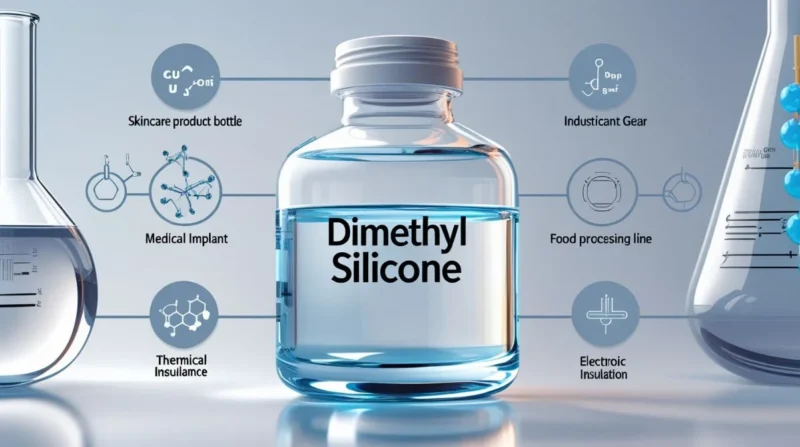Table of Contents
What Is Dimethyl Silicone?
Dimethyl silicone, also known as polydimethylsiloxane (PDMS) or dimethicone, is a clear, odorless, and non-toxic silicone-based compound widely used across various industries due to its unique properties. It exhibits excellent thermal stability, low surface tension, and resistance to moisture, making it an ideal choice for applications ranging from personal care products to industrial lubricants.
Key Properties of Dimethyl Silicone
Dimethyl silicone possesses several notable characteristics:
- Thermal Stability: It remains stable at high temperatures, making it suitable for various industrial applications.
- Low Surface Tension: This property allows it to spread easily over surfaces, enhancing its effectiveness in applications like defoaming and lubrication.
- Chemical Inertness: Dimethyl silicone is chemically inert, meaning it doesn’t react easily with other substances, ensuring its stability in various formulations.
- Electrical Insulation: It serves as an excellent electrical insulator, making it valuable in electronic applications.
- Water Repellency: Its hydrophobic nature makes it effective in water-repellent coatings and treatments.
Applications of Dimethyl Silicone
1. Personal Care Products
In the personal care industry, dimethyl silicone is commonly found in products like shampoos, conditioners, and skin lotions. It imparts a smooth, silky feel to hair and skin, reduces frizz, and enhances the spreadability of creams and lotions. Its ability to form a protective barrier on the skin helps in retaining moisture, making it a popular ingredient in moisturizers and anti-aging products.
2. Medical and Pharmaceutical Uses
Dimethyl silicone plays a crucial role in the medical field. It is used in the manufacturing of medical devices such as catheters, implants, and contact lenses due to its biocompatibility and flexibility. Additionally, it serves as an active ingredient in over-the-counter medications for treating digestive issues, acting as an anti-foaming agent to relieve bloating and discomfort.
3. Industrial Applications
In industrial settings, dimethyl silicone functions as a lubricant, release agent, and defoamer. Its thermal stability and resistance to oxidation make it suitable for use in high-temperature environments, such as in the automotive and aerospace industries. Moreover, it is employed in the production of textiles, providing softness and water repellency to fabrics.
4. Food Industry
Dimethyl silicone is used as an anti-foaming agent in food processing, helping to control foam during the production of various food items. Its non-toxic nature ensures it doesn’t affect the safety or quality of the food products.
Chemical Reactions of Dimethyl Silicone
While dimethyl silicone is known for its chemical inertness, it can undergo specific reactions under certain conditions:
1. Crosslinking Reaction
Purpose: To transform liquid silicone into solid rubber or gel.
Mechanism: In the presence of moisture and a catalyst (such as tin or platinum), the ends of silicone chains react to form a solid structure. This process is common in the production of sealants, medical implants, and molds.
2. Decomposition at High Temperatures
Although heat-resistant, dimethyl silicone can decompose at very high temperatures (above 300°C to 400°C), producing silica (SiO₂), methane (CH₄), and other small organic compounds.
3. Hydrolysis Reaction
Purpose: Used in manufacturing or breaking down silicone.
Mechanism: When reacting with water, especially in acidic or basic environments, dimethyl silicone can slowly break its Si–O bonds. This reaction is useful in recycling or modifying silicone materials.
4. Oxidation Reaction
Dimethyl silicone is resistant to oxygen, but prolonged exposure to strong oxidizers (like hydrogen peroxide or ozone) can oxidize it. This can change methyl groups (–CH₃) into hydroxyl (–OH) or carboxyl (–COOH) groups, altering the silicone’s properties.
5. Reaction with Strong Acids or Bases
Generally stable, dimethyl silicone can have its siloxane bonds (Si–O–Si) broken apart when exposed to strong acids (like HCl) or strong bases (like NaOH) at high temperatures or over extended periods. This process is often controlled in laboratory settings for modifying or recycling silicone materials.
Environmental Considerations
While dimethyl silicone is generally considered safe for human use, environmental concerns exist. Some studies suggest that certain forms of silicones can persist in the environment and may bioaccumulate, potentially impacting aquatic life. However, ongoing research and development aim to create more sustainable and biodegradable alternatives to minimize environmental footprints.
Frequently Asked Questions
Q1. What is dimethyl silicone used for?
Dimethyl silicone is utilized in various industries, including cosmetics, medicine, food, and manufacturing. It smooths skin and hair, acts as a lubricant, prevents foam in food and medicine, and serves as an insulator in electronics.
Q2. Is dimethyl silicone safe for skin?
Yes, dimethyl silicone (often listed as dimethicone in skincare products) is considered safe for most skin types. It helps lock in moisture, reduce irritation, and provides a silky feel. However, individuals with very sensitive skin should perform a patch test first.
Q3. Can dimethyl silicone cause acne?
While dimethyl silicone itself is non-comedogenic (doesn’t clog pores), some people may experience breakouts if it’s combined with other heavy ingredients. It forms a barrier on the skin, so proper cleansing is essential.
Q4. Is dimethyl silicone harmful to the environment?
Although safe for humans, certain types of silicone can persist in nature and may not break down easily. Researchers are working on eco-friendly alternatives to reduce long-term environmental impacts.
Q5. Is dimethyl silicone the same as silicone oil?
Yes, dimethyl silicone is a type of silicone oil. It is clear, stable, and widely used in industrial and personal care products due to its flexibility and resistance to heat and chemicals.
Conclusion
Dimethyl silicone is a versatile compound with applications ranging from personal care to industrial manufacturing. Its unique properties enhance the performance and user experience of various products. However, mindful usage and continued innovation are essential to address environmental concerns and ensure sustainable practices in its application.
Related Topic: Methyl Formate: Properties, Production, Uses, and Market Trends









